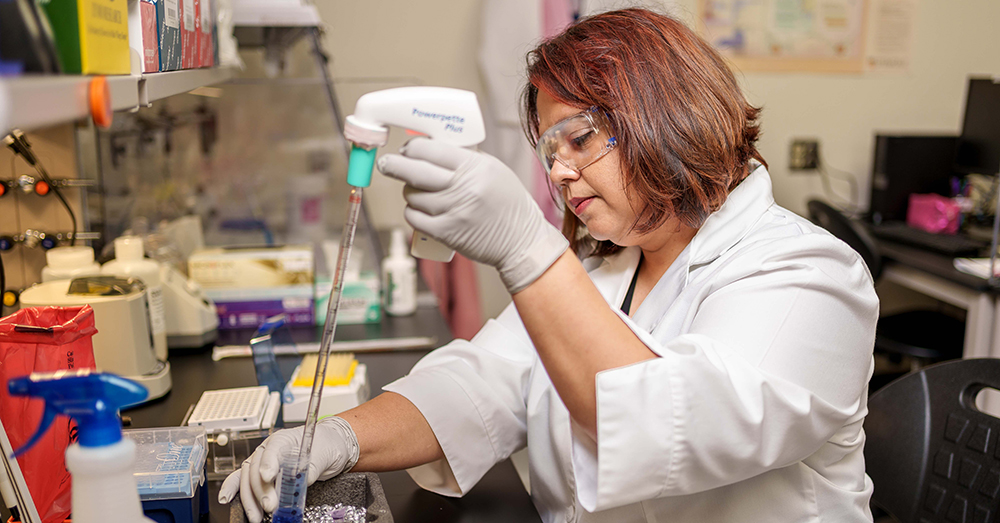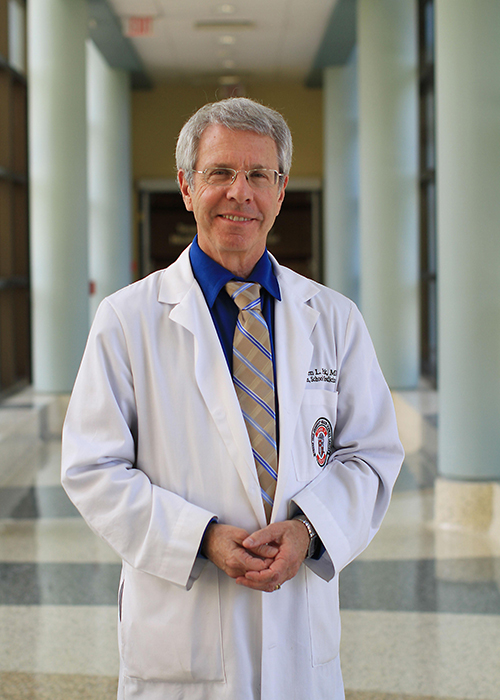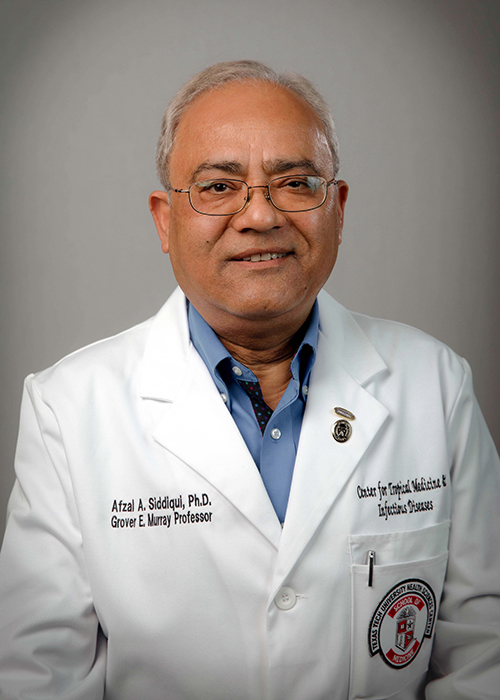Gene Sequencing an Important Tool in COVID-19 Battle
TTUHSC, Texas Tech Institute for Environmental and Human Health Lead Area Sequencing Effort

Sharilyn Almodóvar, Ph.D.
Despite the focused efforts of scientists, medical professionals and public health experts to defeat SARS-CoV-2, the novel coronavirus that causes COVID-19, the pandemic has continued elbowing its way into our daily lives for more than two years. As promising vaccines and pills are developed, the virus mutates to create a new variant in an effort to outmaneuver the latest treatments and remain active.
And so it goes, with early strains such as alpha, beta and gamma giving way to later mutations such as delta and omicron and its many sub-lineages (e.g., BA.1 and BA.2, BA.3, and currently BA.4 and BA.5). So how does science keep pace with the COVID-19 treatments when the virus itself is a moving target?
The answer is gene sequencing, a process by which scientists determine the sequential order of the four building blocks that comprise a strand of DNA. Those building blocks, known as nucleotides, include adenine, thymine, cytosine and guanine. Millions and billions of these nucleotides are linked together in each of us, giving us our unique genome that houses all of the genetic information that makes us tick.

Sharilyn Almodóvar, Ph.D.
When an organism reproduces, it passes a copy of its entire genome to its descendants. However, errors sometimes occur during the replication process, which means one or more of the four building-block nucleotides are swapped, deleted or otherwise altered. This in turn can modify genes and affect the functions of the replicated genome. In humans, genetic modifications, or mutations help determine characteristics such as eye color. In a virus like SARS-CoV-2, they can alter, for better or worse, the organism’s capacity to spread from host to host, the severity of its infection or its ability to evade vaccines and other potential treatments.
Gene sequencing in general has long been a tool employed by microbiologists, and it is a key public health response to the COVID-19 pandemic. Sharilyn Almodóvar, Ph.D., an investigator for the Department of Immunology and Molecular Microbiology at the Texas Tech University Health Sciences Center (TTUHSC) School of Medicine, said the methods used to conduct sequencing can be adapted to meet almost any situation, which means its potential uses are virtually endless.
“In the specific case of the COVID-19 pandemic, gene sequencing is the tool that gets us to know the virus that we are fighting,” Almodóvar said. “Every single time the virus finds a host to replicate, the new viruses appear with mutations Viral gene sequencing allows us to identify those mutations, how fast they propagate, where those mutations are spread in terms of geographical location and what time of the year this is happening. All of that is key to what we call virus surveillance.”
Most mutations are harmless to the host, but they will eventually improve the odds of the virus more efficiently replicating in the next host. Almodóvar said it’s critical to track virus mutations because that's precisely how new variants are identified.
“This is how we know the enemy that we're fighting,” Almodóvar added. “Coronaviruses have been around for a long time, but this pandemic has been different in many ways.”

Steven L. Berk, M.D.
TTUHSC School of Medicine Dean Steven L. Berk, M.D., agreed and said the Texas Tech Institute for Environmental and Human Health (TIEHH), established in 1999 as a bioterrorism response laboratory, initiated a genomic sequencing program for classifying variants of the SARS-COV-2 virus. The program helps public health officials to better understand the progression of the virus and the impact of its variants upon the local population.
“While gene sequencing is done by many laboratories around the state, country and world, it is important to know the COVID-19 variants that are circulating in West Texas,” Berk explained. “The TIEHH laboratory is providing that information to physicians, hospitals and public health officials.”
Information provided by the TIEHH laboratory will help prepare health care workers for any new developments related to the pandemic. Should there be another delta-like variant, or any additional contagious or virulent variants, Afzal A. Siddiqui., Ph.D., director of TTUHSC’s Center for Tropical Medicine and Infectious Diseases, said gene sequencing would identify the strain and help determine whether or not new public health measures — or a return to previous guidelines — might be necessary.
“Gene sequencing [also] will warn us of any variants that might evade the immune system of vaccinated individuals,” Siddiqui said. “It will also help us track any new strains from one place to another and provide clues to how strains are spreading among populations.”

Afzal A. Siddiqui., Ph.D.
The TIEHH laboratory for gene sequencing provides a very important tool to continue the effective fight against the COVID 19 pandemic in West Texas. Berk said TTUHSC, its regional campuses and centers of excellence are an integral part of that endeavor.
“TTUHSC faculty and staff are facilitating the collection and transport of samples from affiliated hospitals to TIEHH in a concerted effort to be prepared for the next COVID-19 surge,” he added.
Gene sequencing also is important in vaccine development. Every time a new variant is identified, one of the first questions asked is whether or not our current vaccine strategy will protect the public against the new variant, or do we need to make adjustments? That adjustment could be either adding another round of booster shots or reformulating the vaccine.
When a new variant does appear, Almodóvar said it is critical to investigate the correlation between the viral sequencing (or viral identity) of the new variant, the damage it causes in the host and the degree to which current vaccines can or cannot prevent further damage. And while gene sequencing is a very potent tool at this stage of the pandemic, she said prevention measures will continue their role as we end this pandemic.
“Cases are low now, but now more than ever we should not drop the ball,” Almodóvar emphasized. “We should remain conscientious about what we can do to prevent further infections, and therefore new viral genetic mutations. I think that's how sequencing is key at this point. Now that we seem to see the light at the end of this pandemic tunnel, COVID-19 sequencing keeps our eyes open in case new concerning variants come up and increases our overall pandemic preparedness.”
Related Stories
TTUHSC Cancer Researcher Honored by National Academy of Inventors
C. Patrick Reynolds, M.D., Ph.D., director of the School of Medicine Pediatric Cancer Research Center at TTUHSC, has dedicated his life as a researcher to developing treatments for childhood cancers.
TTUHSC’s Hudson Set to Serve as President for Society of Clinical Research Associates
The Society of Clinical Research Associates (SOCRA) has elected Texas Tech University Health Sciences Center’s (TTUHSC) Catherine Hudson, Dr.P.H., as its president for 2025-2026.
Clinical Research Institute a Source of Pride for Retiring Griswold
Upon his retirement, John Griswold, M.D., reflects on the Clinical Research Institute and what it has achieved.
Recent Stories
Making Mental Health a Priority in the New Year
Sarah Mallard Wakefield, M.D., a psychiatrist with Texas Tech Physicians, talks about strategies to combat widespread and growing anxiety.
TTUHSC Cancer Researcher Honored by National Academy of Inventors
C. Patrick Reynolds, M.D., Ph.D., director of the School of Medicine Pediatric Cancer Research Center at TTUHSC, has dedicated his life as a researcher to developing treatments for childhood cancers.
TTUHSC School of Nursing Celebrates 10 Years of the Veteran to BSN Program
The TTUHSC School of Nursing recognized the 10-year anniversary of the Veteran to Bachelor of Science in Nursing (VBSN) program during the fall 2025 commencement ceremonies held Dec. 13 in Lubbock, Texas.
